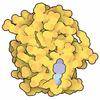Entry Database : PDB / ID : 3vn2Title Crystal Structure of PPARgamma complexed with Telmisartan Nuclear receptor coactivator 1 Peroxisome proliferator-activated receptor gamma Keywords Function / homology Function Domain/homology Component
/ / / / / / / / / / / / / / / / / / / / / / / / / / / / / / / / / / / / / / / / / / / / / / / / / / / / / / / / / / / / / / / / / / / / / / / / / / / / / / / / / / / / / / / / / / / / / / / / / / / / / / / / / / / / / / / / / / / / / / / / / / / / / / / / / / / / / / / / / / / / / / / / / / / / / / / / / / / / / / / / / / Biological species Homo sapiens (human)Method / / / Resolution : 2.18 Å Authors Amano, Y. Journal : Hypertens Res / Year : 2012Title : Structural basis for telmisartan-mediated partial activation of PPAR gammaAuthors : Amano, Y. / Yamaguchi, T. / Ohno, K. / Niimi, T. / Orita, M. / Sakashita, H. / Takeuchi, M. History Deposition Dec 21, 2011 Deposition site / Processing site Revision 1.0 Mar 7, 2012 Provider / Type Revision 1.1 Jul 17, 2013 Group Revision 1.2 Mar 20, 2024 Group / Database references / Derived calculationsCategory chem_comp_atom / chem_comp_bond ... chem_comp_atom / chem_comp_bond / database_2 / struct_ref_seq_dif / struct_site Item _database_2.pdbx_DOI / _database_2.pdbx_database_accession ... _database_2.pdbx_DOI / _database_2.pdbx_database_accession / _struct_ref_seq_dif.details / _struct_site.pdbx_auth_asym_id / _struct_site.pdbx_auth_comp_id / _struct_site.pdbx_auth_seq_id
Show all Show less
 Open data
Open data Basic information
Basic information Components
Components Keywords
Keywords Function and homology information
Function and homology information Homo sapiens (human)
Homo sapiens (human) X-RAY DIFFRACTION /
X-RAY DIFFRACTION /  SYNCHROTRON /
SYNCHROTRON /  MOLECULAR REPLACEMENT / Resolution: 2.18 Å
MOLECULAR REPLACEMENT / Resolution: 2.18 Å  Authors
Authors Citation
Citation Journal: Hypertens Res / Year: 2012
Journal: Hypertens Res / Year: 2012 Structure visualization
Structure visualization Molmil
Molmil Jmol/JSmol
Jmol/JSmol Downloads & links
Downloads & links Download
Download 3vn2.cif.gz
3vn2.cif.gz PDBx/mmCIF format
PDBx/mmCIF format pdb3vn2.ent.gz
pdb3vn2.ent.gz PDB format
PDB format 3vn2.json.gz
3vn2.json.gz PDBx/mmJSON format
PDBx/mmJSON format Other downloads
Other downloads 3vn2_validation.pdf.gz
3vn2_validation.pdf.gz wwPDB validaton report
wwPDB validaton report 3vn2_full_validation.pdf.gz
3vn2_full_validation.pdf.gz 3vn2_validation.xml.gz
3vn2_validation.xml.gz 3vn2_validation.cif.gz
3vn2_validation.cif.gz https://data.pdbj.org/pub/pdb/validation_reports/vn/3vn2
https://data.pdbj.org/pub/pdb/validation_reports/vn/3vn2 ftp://data.pdbj.org/pub/pdb/validation_reports/vn/3vn2
ftp://data.pdbj.org/pub/pdb/validation_reports/vn/3vn2 Links
Links Assembly
Assembly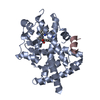
 Components
Components Homo sapiens (human) / Gene: PPARG / Production host:
Homo sapiens (human) / Gene: PPARG / Production host: 
 Homo sapiens (human) / References: UniProt: Q15788
Homo sapiens (human) / References: UniProt: Q15788 X-RAY DIFFRACTION / Number of used crystals: 1
X-RAY DIFFRACTION / Number of used crystals: 1  Sample preparation
Sample preparation SYNCHROTRON / Site:
SYNCHROTRON / Site:  Photon Factory
Photon Factory  / Beamline: AR-NE3A / Wavelength: 1 Å
/ Beamline: AR-NE3A / Wavelength: 1 Å Processing
Processing MOLECULAR REPLACEMENT / Resolution: 2.18→26.93 Å / Cor.coef. Fo:Fc: 0.933 / Cor.coef. Fo:Fc free: 0.909 / SU B: 0.012 / SU ML: 0 / Cross valid method: THROUGHOUT / ESU R Free: 0.242 / Stereochemistry target values: MAXIMUM LIKELIHOOD
MOLECULAR REPLACEMENT / Resolution: 2.18→26.93 Å / Cor.coef. Fo:Fc: 0.933 / Cor.coef. Fo:Fc free: 0.909 / SU B: 0.012 / SU ML: 0 / Cross valid method: THROUGHOUT / ESU R Free: 0.242 / Stereochemistry target values: MAXIMUM LIKELIHOOD Movie
Movie Controller
Controller






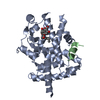



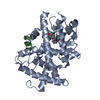




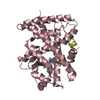

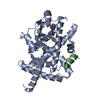
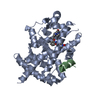
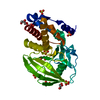

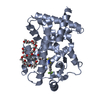
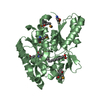
 PDBj
PDBj



